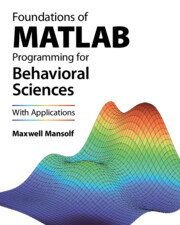Refine search
Actions for selected content:
101 results

Foundations of MATLAB Programming for Behavioral Sciences
- With Applications
- Coming soon
-
- Expected online publication date:
- October 2025
- Print publication:
- 07 August 2025
-
- Textbook
- Export citation

Big Data in the Psychological Sciences
- Coming soon
-
- Expected online publication date:
- October 2025
- Print publication:
- 23 October 2025
-
- Textbook
- Export citation
The (Statistical) Power of Incentives
-
- Journal:
- Journal of the Economic Science Association ,
- Published online by Cambridge University Press:
- 08 October 2025, pp. 1-18
-
- Article
-
- You have access
- Open access
- HTML
- Export citation
Estimating the Local Average Treatment Effect Without the Exclusion Restriction
-
- Journal:
- Political Analysis , First View
- Published online by Cambridge University Press:
- 21 July 2025, pp. 1-15
-
- Article
- Export citation
Balancing Precision and Retention in Experimental Design
-
- Journal:
- Political Analysis , First View
- Published online by Cambridge University Press:
- 21 July 2025, pp. 1-10
-
- Article
-
- You have access
- Open access
- HTML
- Export citation
The ABC mechanism: an incentive compatible payoff mechanism for elicitation of outcome and probability transformations
-
- Journal:
- Experimental Economics / Volume 24 / Issue 3 / September 2021
- Published online by Cambridge University Press:
- 14 March 2025, pp. 1019-1046
-
- Article
- Export citation
Does anonymity affect the willingness to accept and willingness to pay gap? A generalization of Plott and Zeiler
-
- Journal:
- Experimental Economics / Volume 18 / Issue 2 / June 2015
- Published online by Cambridge University Press:
- 14 March 2025, pp. 173-184
-
- Article
- Export citation
Context matters
-
- Journal:
- Experimental Economics / Volume 21 / Issue 4 / December 2018
- Published online by Cambridge University Press:
- 14 March 2025, pp. 723-756
-
- Article
-
- You have access
- Open access
- HTML
- Export citation
Improving the statistical power of economic experiments using adaptive designs
-
- Journal:
- Experimental Economics / Volume 26 / Issue 2 / April 2023
- Published online by Cambridge University Press:
- 14 March 2025, pp. 357-382
-
- Article
-
- You have access
- Open access
- HTML
- Export citation
The Limitations of Experimental Design: A Case Study Involving Monetary Incentive Effects in Laboratory Markets
-
- Journal:
- Experimental Economics / Volume 8 / Issue 1 / April 2005
- Published online by Cambridge University Press:
- 14 March 2025, pp. 21-33
-
- Article
- Export citation
Incentives in experiments with objective lotteries
-
- Journal:
- Experimental Economics / Volume 23 / Issue 1 / March 2020
- Published online by Cambridge University Press:
- 14 March 2025, pp. 1-29
-
- Article
- Export citation
Do control questions influence behavior in experiments?
-
- Journal:
- Experimental Economics / Volume 18 / Issue 2 / June 2015
- Published online by Cambridge University Press:
- 14 March 2025, pp. 185-194
-
- Article
- Export citation
Risky choices and solidarity: disentangling different behavioural channels
-
- Journal:
- Experimental Economics / Volume 24 / Issue 4 / December 2021
- Published online by Cambridge University Press:
- 14 March 2025, pp. 1185-1214
-
- Article
-
- You have access
- Open access
- HTML
- Export citation
Experimenter demand effects in economic experiments
-
- Journal:
- Experimental Economics / Volume 13 / Issue 1 / March 2010
- Published online by Cambridge University Press:
- 14 March 2025, pp. 75-98
-
- Article
- Export citation
So you want to run an experiment, now what? Some simple rules of thumb for optimal experimental design
-
- Journal:
- Experimental Economics / Volume 14 / Issue 4 / November 2011
- Published online by Cambridge University Press:
- 14 March 2025, pp. 439-457
-
- Article
- Export citation
A penny for your thoughts: a survey of methods for eliciting beliefs
-
- Journal:
- Experimental Economics / Volume 18 / Issue 3 / September 2015
- Published online by Cambridge University Press:
- 14 March 2025, pp. 457-490
-
- Article
- Export citation
Trust, Reciprocity, and Social History: A Re-examination
-
- Journal:
- Experimental Economics / Volume 3 / Issue 1 / June 2000
- Published online by Cambridge University Press:
- 14 March 2025, pp. 81-100
-
- Article
- Export citation
Session-effects in the laboratory
-
- Journal:
- Experimental Economics / Volume 15 / Issue 3 / September 2012
- Published online by Cambridge University Press:
- 14 March 2025, pp. 485-498
-
- Article
- Export citation
A better future for mental health science
-
- Journal:
- The British Journal of Psychiatry / Volume 227 / Issue 3 / September 2025
- Published online by Cambridge University Press:
- 10 March 2025, pp. 588-589
- Print publication:
- September 2025
-
- Article
-
- You have access
- HTML
- Export citation
The Limits (and Strengths) of Single-Topic Experiments
-
- Journal:
- Political Analysis / Volume 33 / Issue 2 / April 2025
- Published online by Cambridge University Press:
- 24 January 2025, pp. 164-170
-
- Article
-
- You have access
- Open access
- HTML
- Export citation
